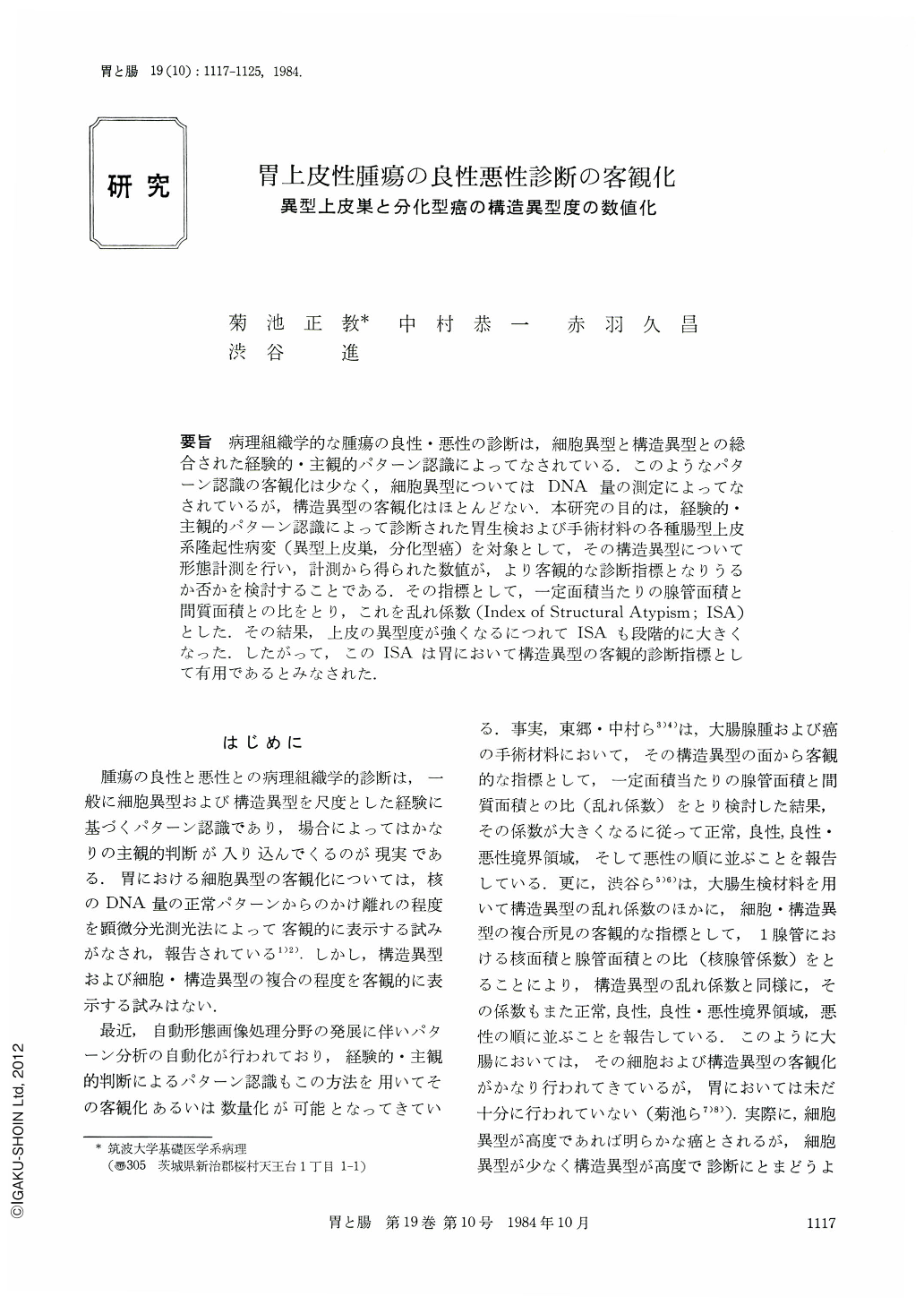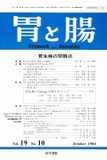Japanese
English
- 有料閲覧
- Abstract 文献概要
- 1ページ目 Look Inside
要旨 病理組織学的な腫瘍の良性・悪性の診断は,細胞異型と構造異型との総合された経験的・主観的パターン認識によってなされている.このようなパターン認識の客観化は少なく,細胞異型についてはDNA量の測定によってなされているが,構造異型の客観化はほとんどない.本研究の目的は,経験的・主観的パターン認識によって診断された胃生検および手術材料の各種腸型上皮系隆起性病変(異型上皮巣,分化型癌)を対象として,その構造異型について形態計測を行い,計測から得られた数値が,より客観的な診断指標となりうるか否かを検討することである.その指標として,一定面積当たりの腺管面積と間質面積との比をとり,これを乱れ係数(lndex of Structural Atypism;ISA)とした.その結果,上皮の異型度が強くなるにつれてISAも段階的に大きくなった.したがって,このISAは胃において構造異型の客観的診断指標として有用であるとみなされた.
Generally speaking, histological interpretation of the tumor of the stomach has been experientially and subjectively done by pattern recognition of cellular and structural atypisms. Objectification of cellular atypism has been studied by means of measurement of DNA values. However, objectification of the structural atypism has never been studied.
Recently, objectification of structural atypism by means of morphometric analysis has been reported on epithelial tumor of the large intestine (Togo S, et al, 1982)3), but has not yet been studied on epithelial tumor of the stomach.
The purpose of this study is to analyse morphometrically the structural atypism on protruded lesions of atypical epithelium (adenoma) and differentiated carcinoma of the stomach, and to examine whether morphometric value obtained from each lesion is useful for differential diagnosis or not.
Materials for this study are protruded lesions of atypical epithelium of intestinal type (adenoma of intestinal type) and differentiated carcinoma in biopsy and surgical specimens (Tables 1, 2 and 3). These lesions were divided into three groups: definitely benign (Fig. 1), definitely malignant (Fig. 2), and borderline groups (Fig. 3). Metaplastic mucosa of intestinal type was used as a control group.
In histological tissues of the materials, area of glands and area of stroma per unit area were measured by image analyser (Fig. 4), and ratio of the area of glands to the area of stroma per unit area was calculated in each lesion. It may be considered that the ratio indicates a summation of density and irregular size of gland in histological preparation. The ratio has been called as index of structural atypism (in the following abbreviated as ISA).
(1) The mean values of ISA measured on biopsy specimen were as follows: intestinalized mucosa as a control was 1.08±0.40, the definitely benign group 2.31±0.71, the borderline group 2.94±0.48, and the differentiated carcinoma group 3.89±0.96 (Table 4). Further, these ISA values showed a normal distribution in each group. Application of t-test among them shows statistically significant difference (p<0.01).
(2) The mean values of ISA measured on surgical specimen were as follows: intestinalized mucosa was 1.17±0.40, the definitely benign group 2.25±0.73, the borderline group 2.81±0.64, and the differentiated carcinoma group 4.09±1.71 (Table 5). These ISA values showed a normal distribution except the differentiated carcinoma group (Figs. 6 and 7). Application of t-test among them yields a p value of less than 0.01.
(3) ISA of biopsy and surgical specimens showed almost the same value in each group (Table 6). The ISA values of the control and three groups are arranged in the order of severity of structural atypism.
Consequently, it may be concluded from these data obtained that the value of ISA is useful to diagnose objectively whether an atypical epithelial lesion of the stomach is benign or malignant.

Copyright © 1984, Igaku-Shoin Ltd. All rights reserved.


